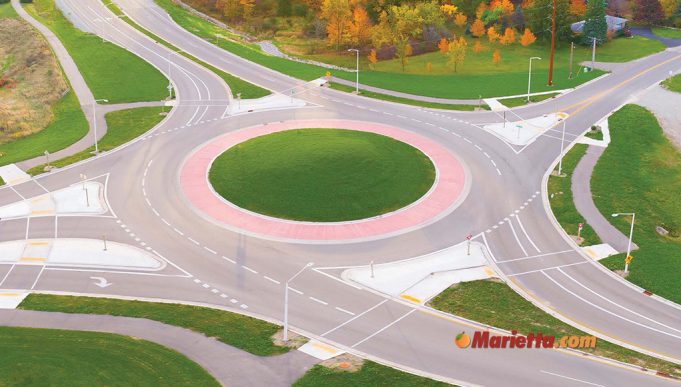The weekend I started writing this column, I had just taken a short drive to nearby Douglasville to buy some produce and flowers from a farmer whose goods I normally just pick up at a local farmers’ market. However, since my wife and I haven’t been venturing outside too much lately, we wanted to hit the road — even if it was just for less than two hours roundtrip.
Near the farm, we drove through what looked like a relatively new roundabout, and I started thinking about how prevalent they’ve become in Georgia and I wondered if people actually knew how to use them, were not scared or intimidated to use them, and if they actually improved traffic flow for a population more accustomed to four-way intersections.
Well, according to the Insurance Institute for Highway Safety (IIHS), roundabouts do work. Studies have shown that roundabouts are safer than traditional stop sign or signal-controlled intersections. Roundabouts reduced injury crashes by 75 percent at intersections where stop signs or signals were previously used for traffic control. Additionally, roundabouts actually move traffic through an intersection more quickly, and with less congestion on approaching roads, the IIHS reports. And if drivers are paying attention to signs, roundabouts are actually easy to navigate, even in areas where you may be unsure of where you’re going.
In Cobb County, residents may not be too familiar with roundabouts. However, I was surprised to learn that we have nearly a dozen already in use and even more under construction. In fact, the Cobb Department of Transportation says it has plans to replace several four-way intersections with roundabouts. “Roundabouts have built-in safety designs that force drivers to slow down and yield to traffic within the lane before entering the roundabout,” the county reports. “Most traffic accidents occur at intersections due to conflict points and intersecting travel paths. By keeping traffic moving in the same direction, roundabouts reduce rear-end collisions — the most common type of collision.”
If you’re unsure how to navigate your way through a roundabout, the county says you should slow your speed, look to your left for approaching vehicles already in or entering the roundabout, and you should only come to a stop if you need to yield to traffic. If no traffic is approaching or in the roundabout, drivers should proceed to the right and exit at the appropriate intersection road. Simple.
If you’re still unconfident, the IIHS has a video on YouTube that will help:

















Thank you for this article.
Fantastic!
More people need to watch the video to learn to navigate!!!
Keep them coming in Cobb, need more!!!